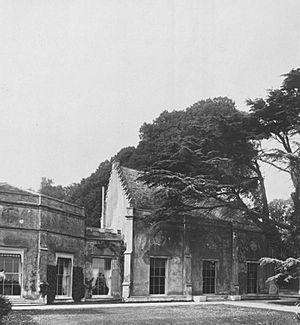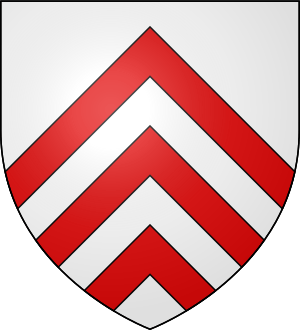Sandleford Priory (monastery) facts for kids
Sandleford Priory was once a small monastery for Augustinian monks. Today, its old buildings are part of a country house in Sandleford, Greenham, in Berkshire, England.
Contents
The Priory's Story
The Priory of St. John the Baptist at Sandleford was started for Augustinian monks by Geoffrey, Earl of Perche, and his wife Maud. This happened sometime between 1193 and 1202.
A very important church leader, Stephen Langton, who was Archbishop of Canterbury, confirmed the priory's dedication to St. John the Baptist and the Virgin Mary.
In 1274, a noblewoman named Maud de Clare tried to change it into a "double house" for both nuns and monks, but this plan didn't happen. The priory was officially closed down in 1478. The few remaining monks left because the priory had been poorly managed for many years by its leader, called a prior.
After the monks left, the ownership of the priory went to the Bishop of Salisbury. Around 1480, it was given to the Dean and Canons of Windsor. The old chapel of the priory is now used as a library in the country house.
On August 31, 1320, King Edward II of England even stayed at Sandleford Priory for a night!
The number of monks at the priory slowly got smaller. When the last prior died in 1478, there were no monks left at all.
Leaders of the Priory
The leaders of a priory were called Priors. Here are some of the people who held that important role:
- Walter (started July 1222)
- John (around 1230-1240)
- Gervase (in 1255)
- Stephen (from 1256-1262)
- Robert de Winchester (started 1301)
- Thomas de Sandleford (from 1311, 1330)
- William de Wynton (resigned 1334)
- Robert [Gilbert] (from 1334)
- John (in 1354-1355)
- John (in 1383-1384)
- Richard Stanford (elected 1403)
- Hugh Warham (elected 1406)
- Symon Dam (removed from his position in 1439-1440)
- William Costyn (elected 1448)
- William Westbury (in 1457). He was also the first headmaster of Eton College.
Who Supported the Priory?
The priory was supported by many important people over the years. These supporters were called "patrons."
The Founding Family
Geoffrey, Earl of Perche, and his wife Matilda of Saxony founded Sandleford Priory. Matilda was a granddaughter of King Henry II of England and Eleanor of Aquitaine. This made her a niece of famous kings like Richard the Lionheart and John of England.
Geoffrey and Matilda gave the priory land and money from the mills in Newbury to help support the monks.
Other Key Supporters
- Maud de Clare (1223–1289), a powerful countess, tried to set up a new type of convent at Sandleford in 1274. Her granddaughter, Elizabeth de Clare, later founded Clare College, Cambridge.
- Alice de Colville gave wheat to the priory to pray for the souls of John Marshal and William Marshal, 1st Earl of Pembroke.
- Richard Beauchamp (died 1481), who was the Bishop of Salisbury, helped give the abandoned priory to the Dean and Canons of Windsor in 1478.
Land and Property
The priory received many gifts of land and property over the years. These gifts helped the monks live and work.
Original Lands
The first gift of land to the priory was described as:
- All the land at Sandleford, surrounded by hedges and ditches.
- A wood called Brademore (Broadmore).
- Land on both sides of the wood, bordered by the River Aleburne and various roads.
Priory's Main Holdings in 1291
A record from 1291, made for Pope Nicholas IV, shows the value of the priory's properties each year:
- £2 8s. 8d. from Newbury
- £1 15s. from Enborne
- £1 6s. from West Ilsley
- 10s. from Aldworth
West Ilsley Lands
The priory received land and rights in West Ilsley. This included an "advowson," which meant they had the right to suggest who should be the priest for the church there.
Midgham Lands
The priory also owned land in nearby Midgham. In the 13th century, this was about 120 acres. Even much later, in the 1700s, this land was still connected to Sandleford.
Kingsclere Woodlands
In 1312, the Prior of Sandleford got permission to add more land to the priory's holdings. This included a house, 20 acres of land, and 2 acres of meadow in 'Clere Wodelond,' near Kingsclere, Hampshire.
Trade and Events
In 1235, the Prior of Sandleford received permission from King Henry III of England to hold a special fair for four days around September 21st. Interestingly, the modern-day Newbury Show is held around these same dates, and it takes place on land that was part of the priory's original property!
In 1293, King Edward I of England gave the priory "free warren" rights on its lands at Sandleford and Enborne. This meant they had the right to hunt small game animals on their own property.
After the Monks Left
After the monks abandoned the priory, the buildings and land were given to the Dean and Canons of Windsor. They then leased it out, often for use as a farm.
Early Lessees
- In 1543, a doctor named John Burges leased the priory for 40 years.
- In 1560, Thomas Hide leased the priory for six years.
- Sir Francis Moore, a lawyer and Member of Parliament, took over the leases in the early 1600s.
- His son, Sir Henry Moore, continued to lease the property in 1624.
The Staples Family
During the time of the English Civil War, the priory's ownership became complicated. In 1651, the property was sold to Thomas Bales, who then sold it to Alexander Staples. The Staples family held rights to the priory for a time.
Eventually, the Kingsmill family leased the house. They turned the old priory buildings into the beautiful country house we see today. Sandleford Priory is now home to St Gabriel's School.




